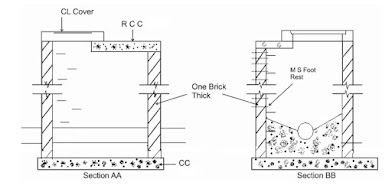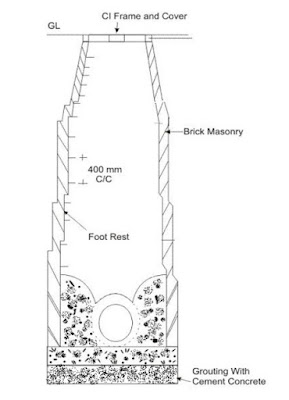Search This Blog
Most Popular
What is Rendering in Construction? Types & Benefits
September 18, 2023
Soak Pit - Function, Types & Design
September 15, 2023
Categories
- Building Construction (86)
- Building Materials (83)
- Columns (2)
- Concrete Beam (3)
- Concrete Construction Techniques (4)
- Concrete Mix Design (13)
- Concrete Repair (14)
- Concrete Slab (10)
- Construction Equipment (16)
- Construction News (7)
- Design of Structures (15)
- Engineering Drawing (1)
- Estimation (3)
- Geotechnical engineering (26)
- Highway Engineering (11)
- Innovations (32)
- Material Testing (10)
- Matrix Analysis of Structures (2)
- Mechanical Engineering (3)
- Strength of Materials (2)
- Structural Analysis (13)
- Structural Design (22)
- Structures (17)
- Transportation Engineering (9)
Types of Manholes | Sewer Appurtenances
Neenu
January 17, 2023
Manholes are underground inspection chambers that provide access to underground utilities like a sewer system. These are one of the major sewer appurtenances and are classified into various types based on their depth and function.
There are three types of manholes they are normal, shallow, and deep. Every kind of manhole is chosen for different applications depending upon the function they need to serve and the size of the sewer or drainage water line. Manholes can be produced using a variety of materials comprising precast concrete, fiberglass, and plastic.
Types of Manholes Based on Depth
Based on the depth criteria, a manhole can be classified into:
- Normal Manhole
- Deep Manhole
- Shallow Manhole
1. Normal Manhole
- Normal manholes are generally 1.5 m in depth. They can take a square or rectangular dimension. Square [1m x 1m] and rectangular [1.2 m x 0.9 m].
- A heavy manhole cover is installed to bear the anticipated traffic load.
 |
| Normal Manhole-Rectangular Cross-Section |
2. Shallow Manhole
- Shallow manholes have depths of less than 1 m around 0.7 m to 0.9 m.
- These manholes are constructed where the traffic loads are less usually at the start of the branch sewer. Hence, it forms the inspection chamber.
- Unlike a normal manhole, a shallow manhole is provided with a light manhole cover.
 |
| Shallow Manhole |
3. Deep Manhole
- The depth of the deep manhole is more significant than 1.5 m.
- These manhole does not have a uniform cross-section throughout. It usually has a smaller upper portion. Steps are provided in such manholes for descending into the manholes.
- Deep manholes are provided with heavy covers to support heavy traffic loads.
 |
| Deep Manhole |
Types of Manholes Based on Function
- Junction Manholes
- Drop-Manhole
- Side-Entrance Manholes
- Scarper Type Manholes
- Flushing-Manholes
1. Junction Manholes
This is a manhole that is constructed at the intersection of two large sewers or at the curved portion of the sewers [where the curved portion will be situated within the manhole].
At the junction, it is recommended to have the soffit of the smaller sewer not be lower than the larger sewer. In addition to this, the smaller sewer can be made steeper from the previous manhole to avoid the difference of invert at the point of junction.
2. Drop-Manhole
This is a manhole drop connection that is used to connect two sewer lines at different elevation or drop (more than 60 cm) so that it safely lead to the main manhole chamber or outlet.
 |
| Drop Manhole |
Read More On: Purpose of Drop Manhole
3. Side Entry Manholes
A side-entry manhole is a type of access point to an underground structure or network, such as a sewer or drainage system, that allows entry from the side rather than the top. The entry point to a side-entry manhole is a horizontal opening or doorway at the side of a vertical shaft or cylinder that extends from the surface to the underground structure.Side-entry manholes are often used in situations where there is limited space or access for equipment and workers, such as in urban areas or narrow streets, or where a top-entry manhole would be unsafe or impractical.
Side-entry manholes typically have a cover or lid that can be removed to allow access, and may also have features such as steps or ladders to facilitate entry and exit.
When direct vertical access to the sewer is not possible due to obstructions (other sewers, gas, water, etc lines), an access shaft is constructed in a position that is near and convenient and off the line of the sewer direction. This is then connected to the manhole by a lateral passage. These are called side entrance manholes.
While designing, the floor of the side entrance passage should enter the chamber not lower than the soffit level of the sewer.
Scraper-type manholes have a clear opening that allows the lowering of buckets. The size of their openings ranges between 1.2 m x 0.9 m.
While designing, the floor of the side entrance passage should enter the chamber not lower than the soffit level of the sewer.
4. Scraper(Service) Type Manhole
Scarper or service-type manholes mandatory for all sewers with a diameter greater than 4.5 m. It is provided at an interval of 110 to 120 m.Scraper-type manholes have a clear opening that allows the lowering of buckets. The size of their openings ranges between 1.2 m x 0.9 m.
5. Flushing-Manholes
This is a manhole located at the head of a sewer to flush out the deposits in the sewer using water. Flushing is carried out using water from the overhead water tank through the pipes and flushing hydrants or fire hydrants or tankers and hoses. They are mainly provided at the head of the sewers.
Most Visited
Sieve Analysis of Aggregates - ASTM Standard
August 11, 2021
How to Choose Good Quality Aggregates for Construction?
August 10, 2021
What are Infiltration Wells?
April 15, 2024
How to Calculate Cement Required for Floor Tiling?
July 02, 2020
Wall Ties or Brick Ties in Construction
June 13, 2022
What is a Cap Beam?
May 15, 2025
Top 7 Waterproofing Materials for Concrete Roofs
December 13, 2024
What is Target Mean Strength? R.C.C Design
July 17, 2021
Construction ERP System – A Comprehensive Guide
December 12, 2024
Search This Blog
MUST READ
What is PERT? Objectives, Pros & Cons
September 10, 2017
Terzaghi's Equation: Soil Bearing Capacity for Foundations
March 02, 2022
Contact Form
Footer Menu Widget
Created By SoraTemplates | Distributed By Gooyaabi Templates



0 Comments
Commenting Spam Links Are Against Policies